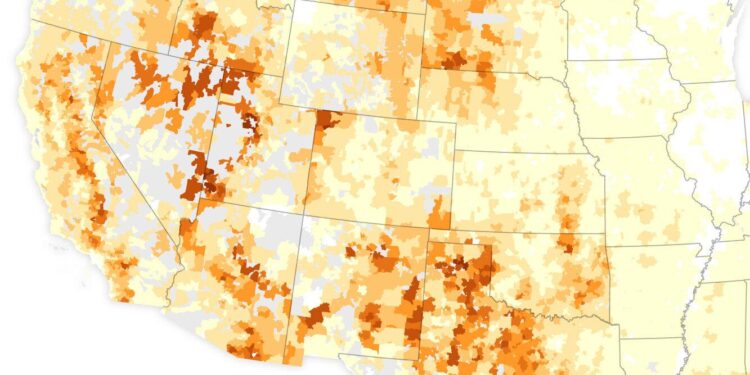As Southeast Europe faces an increasingly severe wildfire season, the IQAir Wildfire Map is providing critical real-time insights into the region’s ongoing blaze events. This interactive tool highlights hotspots, tracks fire spread, and informs both authorities and the public about air quality hazards caused by the intense smoke plumes. In this article, we delve into the latest developments captured by the IQAir platform, examining the scale and impact of wildfires across Southeast Europe and the steps being taken to combat this growing threat.
Wildfire Map Spotlight Reveals Rising Fire Incidents in Southeast Europe
Recent data visualizations display a marked increase in wildfire outbreaks across Southeast Europe, highlighting the region’s escalating vulnerability amid changing climate patterns. Countries such as Greece, Bulgaria, and Romania have reported dozens of new fire incidents over the past month, with many blazes expanding rapidly due to prolonged drought conditions and intense heatwaves. This surge not only threatens vast forested areas but also endangers rural communities and critical infrastructure.
Key factors driving the rising wildfire trend include:
- Extended periods of extreme heat combined with low precipitation
- Accumulated dry vegetation acting as natural fuel
- Insufficient firefighting resources in remote locations
- Increased human activities igniting accidental fires
| Country | New Fire Incidents (Last 30 days) | Affected Area (hectares) |
|---|---|---|
| Greece | 47 | 3,850 |
| Bulgaria | 32 | 1,920 |
| Romania | 28 | 1,400 |
| Serbia | 15 | 890 |
Analyzing the Environmental and Health Impacts of Southeast Europe Wildfires
The recent wildfire outbreaks across Southeast Europe have sent shockwaves throughout the region, with far-reaching consequences on both the environment and public health. Dense plumes of smoke have not only devastated vast forested areas but have also severely compromised air quality in urban and rural communities alike. Particulate matter (PM2.5 and PM10) concentrations have surged, often exceeding safe limits established by the World Health Organization, leading to an increase in respiratory ailments and cardiovascular stress among vulnerable populations. Local ecosystems are also under strain, as prolonged fires disrupt wildlife habitats and soil fertility, threatening biodiversity and hampering natural regeneration.
Analyzing the immediate and long-term repercussions reveals a complex interplay between environmental degradation and human health risks. Apart from the obvious loss of flora and fauna, the release of greenhouse gases like carbon dioxide and methane exacerbates climate change, creating a cycle of increased wildfire risk in the future. Communities experience disproportionate effects, with children, the elderly, and those with pre-existing conditions bearing the brunt of air pollution spikes. The table below summarizes key environmental and health impacts observed during this wildfire season:
| Impact Category | Description | Short-Term Effects | Long-Term Consequences |
|---|---|---|---|
| Air Quality | Elevated PM2.5 and PM10 levels | Respiratory irritation, asthma attacks | Chronic lung diseases, increased mortality |
| Wildlife | Habitat destruction and displacement | Loss of fauna, disrupted food chains | Declines in biodiversity, ecosystem imbalance |
| Carbon Emissions | Release of CO‚āā and methane | Contributes to regional haze | Amplifies global warming trends |
| Soil Health | Loss of organic matter and nutrients | Increased erosion, poor soil stability | Reduced agricultural productivity |
- Communities are coping with emergency health advisories and evacuation orders.
- Authorities have intensified firefighting efforts but face challenges due to climate conditions.
- Communities are currently facing emergency health advisories and evacuation mandates due to deteriorating air quality and wildfire dangers.
- Authorities have ramped up firefighting efforts; however, ongoing climate conditions such as higher temperatures and drought complicate containment efforts.
- Enhanced early detection: Utilizing satellite imagery and AI-based monitoring tools to spot fires before they expand.
- Community training programs: Educating residents on fire safety, evacuation routes, and emergency communication.
- Improved cross-border cooperation: Synchronizing efforts among Southeast European nations to efficiently share resources and intelligence.
The recent wildfire outbreaks in Southeast Europe have caused significant environmental and public health challenges, as highlighted below:
Key Environmental and Health Impacts:
| Impact Category | Description | Short-Term Effects | Long-Term Consequences |
|—————–|———————————-|——————————–|———————————-|
| Air Quality | Elevated PM2.5 and PM10 levels | Respiratory irritation, asthma attacks | Chronic lung diseases, increased mortality |
| Wildlife | Habitat destruction and displacement | Loss of fauna, disrupted food chains | Declines in biodiversity, ecosystem imbalance |
| Carbon Emissions | Release of CO‚āā and methane | Contributes to regional haze | Amplifies global warming trends |
| Soil Health | Loss of organic matter and nutrients | Increased erosion, poor soil stability | Reduced agricultural productivity |
Additional Context:
Summary:
Wildfires in Southeast Europe have triggered elevated particulate matter levels that severely impact respiratory and cardiovascular health. The destruction of wildlife habitats and soil degradation threaten ecological balance and agricultural viability. Moreover, the release of greenhouse gases contributes to climate change, heightening future wildfire risks. Vulnerable groups including children, elderly, and individuals with pre-existing health issues are disproportionately affected.
If you would like, I can also help with specific data analysis, recommendations for mitigation strategies, or drafting detailed reports on this topic.
Expert Recommendations for Mitigating Wildfire Risks in the Region
Authorities and environmental experts emphasize a multi-layered approach to reduce wildfire incidences and mitigate their devastating effects across Southeast Europe. Central to prevention is the implementation of rigorous land management practices, such as controlled burns and the removal of dry underbrush that often serve as tinder for fast-spreading fires. Additionally, upgrading local firefighting infrastructure and response systems has been highlighted:
Besides prevention, adaptation strategies focus on fostering landscapes that are more resilient to fire. Experts advocate for restoring native vegetation, which is naturally less flammable, and implementing urban planning that reduces vulnerability in fire-prone zones. The table below outlines key expert-advocated measures along with potential benefits and challenges faced in the region:
| Mitigation Strategy | Benefits | Challenges | |
|---|---|---|---|
| Controlled Burns | Reduces fuel load, prevents large wildfires | Requires expert execution, risk of escape | |
| AI Fire Detection | Faster response times, real-time monitoring | High initial cost, data dependency | |
| Community Training Programs | Increases public awareness, enhances safety | Requires ongoing engagement, resource-intensive | |
| Cross-border Cooperation | Better resource allocation, unified response | Political complexities, coordination challenges | |
| Restoration of Native Vegetation | Increases landscape resilience, supports biodiversity | Long-term process, requires funding | |
| Fire-Resilient Urban Planning | Reduces damage to infrastructure, improves evacuation | Needs policy support, possible high costs |
















